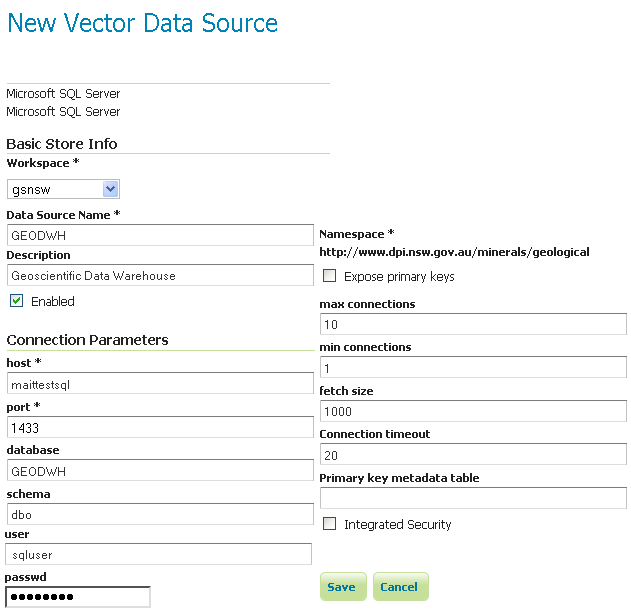Microsoft SQL Server¶
Note
GeoServer does not come built-in with support for SQL Server; it must be installed through an extension. Proceed to Installing the SQL Server extension for installation details.
Microsoft’s SQL Server is a relational database with spatial functionality.
Supported versions¶
The extension supports SQL Server 2008.
Installing the SQL Server extension¶
Warning
Due to licensing requirements, not all files are included with the extension. To install SQL Server support, it is necessary to download additional files.
GeoServer files¶
Download the SQL Server extension from the GeoServer download page.
Warning
Make sure to match the version of the extension to the version of the GeoServer instance!
Extract the contents of the archive into the WEB-INF/lib directory of the GeoServer installation.
Microsoft files¶
- Navigate to Microsoft’s JDBC driver download page.
- Download using the Download SQL Server JDBC Driver 3.0 link.
- Accept the license and download the appropriate archive for your operating system.
- Extract the contents of the archive
- Copy the file sqljdbc4.jar to the WEB-INF/lib directory of the GeoServer installation.
- For GeoServer installed on Windows, copy \x86\sqljdbc_auth.dll and \x86\sqljdbc_xa.dll to C:\Windows\System32
Adding a SQL Server database¶
Once the extension is properly installed SQL Server will show up as an option when creating a new data store.

SQL Server in the list of vector data sources
Configuring a SQL Server data store¶

Configuring a SQL Server data store
| host | The sql server instance host name or ip address, only. Note that server\instance notation is not accepted - specify the port below, instead, if you have a non-default instance. |
| port | The port on which the SQL server instance is accepting connections. See the note below. |
| database | The name of the database to connect to. |
| schema | The database schema to access tables from (optional). |
| user | The name of the user to connect to the oracle database as. |
| password | The password to use when connecting to the database. Leave blank for no password. |
max connections min connections |
Connection pool configuration parameters. See the Database Connection Pooling section for details. |
Determining the port used by the SQL Server instance¶
You can determine the port in use by connecting to your SQL server instance using some other software, and then using netstat to display details on network connections. In the following example on a Windows PC, the port is 2646 ..
C:\>netstat -a | find "sql1"
TCP DPI908194:1918 maittestsql1.dpi.nsw.gov.au:2646 ESTABLISHED